BOP: Alcatraz (original) (raw)

Alcatraz Origins
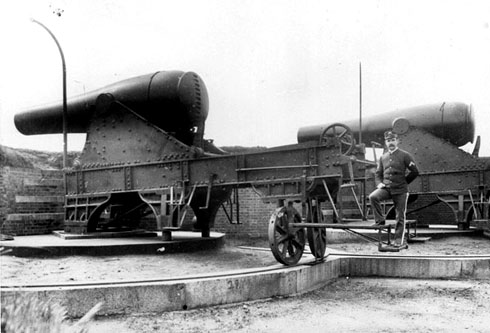
Soldier with artillery canon atop Alcatraz island
The name Alcatraz is derived from the Spanish "Alcatraces." In 1775, the Spanish explorer Juan Manuel de Ayala was the first to sail into what is now known as San Francisco Bay - his expedition mapped the bay and named one of the three islands Alcatraces. Over time, the name was Anglicized to Alcatraz. While the exact meaning is still debated, Alcatraz is usually defined as meaning "pelican" or "strange bird."
In 1850, a presidential order set aside the island for possible use as a United States military reservation. The California Gold Rush, the resulting boom in the growth of San Francisco, and the need to protect San Francisco Bay led the U.S. Army to build a Citadel, or fortress, at the top of the island in the early 1850s. The Army also made plans to install more than 100 cannons on the island, making Alcatraz the most heavily fortified military site on the West Coast. Together with Fort Point and Lime Point, Alcatraz formed a "triangle of defense" designed to protect the entrance to the bay. The island was also the site of the first operational lighthouse on the West Coast of the United States.
By the late 1850s, the first military prisoners were being housed on the island. While the defensive necessity of Alcatraz diminished over time (the island never fired its guns in battle), its role as a prison would continue for more than 100 years. In 1909, the Army tore down the Citadel, leaving its basement level to serve as the foundation for a new military prison. From 1909 through 1911, the military prisoners on Alcatraz built the new prison, which was designated the Pacific Branch, U.S. Disciplinary Barracks for the U.S. Army. It was this prison building that later became famous as "The Rock."
The U.S. Army used the island for more than 80 years--from 1850 until 1933, when the island was transferred to the U.S. Department of Justice for use by the Federal Bureau of Prisons. The Federal Government had decided to open a maximum-security, minimum-privilege penitentiary to deal with the most incorrigible inmates in Federal prisons, and to show the law-abiding public that the Federal Government was serious about stopping the rampant crime of the 1920s and 1930s.
Life at the prison
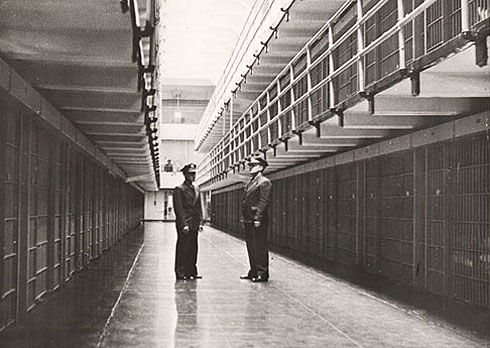
Correctional officers patrol "broadway"
While several well-known criminals, such as Al Capone, George "Machine-Gun" Kelly, Alvin Karpis (the first "Public Enemy #1"), and Arthur "Doc" Barker did time on Alcatraz, most of the prisoners incarcerated there were not well-known gangsters, but prisoners who refused to conform to the rules and regulations at other Federal institutions, who were considered violent and dangerous, or who were considered escape risks.
The average population was only about 260-275 (the prison never once reached its capacity of 336 - at any given time, Alcatraz held less than 1 percent of the total Federal prison population). Many prisoners actually considered the living conditions (for instance, always one man to a cell) at Alcatraz to be better than other Federal prisons, and several inmates actually requested a transfer to Alcatraz. But while USP Alcatraz was not the "America's Devil's Island" that books and movies often portrayed, it was designed to be a prison system's prison.
If a man did not behave at another institution, he could be sent to Alcatraz, where the highly structured, monotonous daily routine was designed to teach an inmate to follow rules and regulations. At Alcatraz, a prisoner had four rights: food, clothing, shelter, and medical care. Everything else was a privilege that had to be earned. Some privileges a prisoner could earn included: working, corresponding with and having visits from family members, access to the prison library, and recreational activities such as painting and music. Once prison officials felt a man no longer posed a threat and could follow the rules (usually after an average of five years on Alcatraz), he could then be transferred back to another Federal prison to finish his sentence and be released.
Bird Man
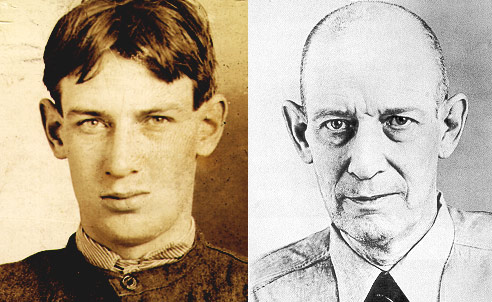
Photos of a young & old Robert Stroud taken from prison
The island's most famous prisoner was probably Robert Stroud, the so-called "Birdman of Alcatraz" who spent 54 years of his life behind bars. Stroud never had any birds at Alcatraz, nor was he the grandfatherly person portrayed by Burt Lancaster in the well-known movie. In 1909, Stroud was convicted of manslaughter; while serving his prison sentence at the U.S. Penitentiary (USP), McNeil Island, Washington, he viciously attacked another inmate. This resulted in his transfer to USP Leavenworth, Kansas. In 1916, he murdered a Leavenworth guard, was convicted of first-degree murder, and received a death sentence. His mother pleaded for his life, and in 1920, President Woodrow Wilson commuted the death sentence to life imprisonment.
It was Stroud's violent behavior that earned him time in segregation. During his 30 years at Leavenworth, he developed his interest in birds and eventually wrote two books about canaries and their diseases. Initially, prison officials allowed Stroud's bird studies because it was seen as a constructive use of his time. However, contraband items were often found hidden in the bird cages, and prison officials discovered that equipment Stroud had requested for his "scientific" studies had actually been used to construct a still for "home-brew." Stroud was transferred to Alcatraz in 1942, where he spent the next 17 years (6 years in segregation in "D Block" and 11 years in the prison hospital). In 1959, he was transferred to the Medical Center for Federal Prisoners in Springfield, Missouri, where he died on November 21, 1963.
Escape Attempts
The 14 Escape Attempts From Alcatraz
1936 - Headstrong
April 27, 1936 -- While working his job burning trash at the incinerator, Joe Bowers began climbing up and over the chain link fence at the island's edge. After refusing orders to climb back down, Bowers was shot by a correctional officer stationed in the West road guard tower, then fell about 50-100 feet to the shore below. He died from his injuries.
1937 - Storm is Brewing
December 16, 1937 -- Theodore Cole and Ralph Roe worked in the mat shop in the model industries building. Over a period of time, while working in the mat shop in the model industries building, they filed their way through the flat iron bars on a window. After climbing through the window, they made their way down to the water's edge and disappeared into San Francisco Bay. This attempt occurred during a bad storm and the Bay's currents were especially fast and strong - most people believe Roe and Cole were swept out to sea. Officially, they are listed missing and presumed dead.
1938 - Workshop attack
May 23, 1938 -- While at work in the woodworking shop in the model industries building, James Limerick, Jimmy Lucas, and Rufus Franklin attacked unarmed correctional officer Royal Cline with a hammer (Cline died from his injuries). The three then climbed to the roof in an attempt to disarm the correctional officer in the roof tower. The officer, Harold Stites, shot Limerick and Franklin. Limerick died from his injuries. Lucas and Franklin received life sentences for Cline's murder.
1939 - The failed five
January 13, 1939 -- Arthur "Doc" Barker, Dale Stamphill, William Martin, Henry Young, and Rufus McCain escaped from the isolation unit in the cellhouse by sawing through the flat iron cell bars and bending tool-proof bars on a window. They then made their way down to the water's edge. Correctional officers found the men at the shoreline on the west side of the island. Martin, Young, and McCain surrendered, while Barker and Stamphill were shot when they refused to surrender. Barker died from his injuries.
1941 - Using the force
May 21, 1941 -- Joe Cretzer, Sam Shockley, Arnold Kyle, and Lloyd Barkdoll took several correctional officers hostage while working in the industries area. The officers, including Paul Madigan (who later became Alcatraz's third warden), were able to convince the four that they could not escape and they surrendered.
1941 - Cold as ice
September 15, 1941 -- While on garbage detail, John Bayless attempted to escape. He gave up shortly after entering the cold water of San Francisco Bay. Later, while appearing in Federal court in San Francisco, Bayless tried, again unsuccessfully, to escape from the courtroom.
1943 - Spidermen
April 14, 1943 -- James Boarman, Harold Brest, Floyd Hamilton, and Fred Hunter took two officers hostage while at work in the industries area. The four climbed out a window and made their way down to the water's edge. One of the hostages was able to alert other officers to the escape and shots were fired at Boarman, Brest, and Hamilton, who were swimming away from the island. Hunter and Brest were both apprehended. Boarman was hit by gunfire and sank below the water before officers were able to reach him; his body was never recovered. Hamilton was initially presumed drowned. However, after hiding out for two days in a small shoreline cave, Hamilton made his way back up to the industries area, where he was discovered by correctional officers.
1943 - Missing Sock
August 7, 1943 -- Huron "Ted" Walters disappeared from the prison laundry building. He was caught at the shoreline, before he could even attempt to enter San Francisco Bay.
1945 - Uncle Sam
July 31, 1945 -- In one of the most ingenious attempts, John Giles was able to take advantage of his job working at the loading dock, where he unloaded army laundry sent to the island to be cleaned - over time, he stole an entire army uniform. Dressed in the uniform, Giles calmly walked aboard an army launch to what he thought was freedom. He was discovered missing almost immediately. Unfortunately for Giles, the launch was headed for Angel Island, not San Francisco as Giles hoped. As Giles set foot on Angel Island, he was met by correctional officers who returned him to Alcatraz.
1946 - Battle of Alcatraz
May 2-4, 1946 -- During this incident, known as the "Battle of Alcatraz" and the "Alcatraz Blastout," six prisoners were able to overpower cellhouse officers and gain access to weapons and cellhouse keys, in effect taking control of the cellhouse. Their plan began to fall apart when the inmates found they did not have the key to unlock the recreation yard door. Shortly thereafter, prison officials discovered the escape attempt. Instead of giving up, Bernard Coy, Joe Cretzer, Marvin Hubbard, Sam Shockley, Miran Thompson, and Clarence Carnes decided to fight. Eventually Shockley, Thompson, and Carnes returned to their cells, but not before the officers taken hostage were shot at point-blank range by Cretzer (encouraged by Shockley and Thompson). One officer, William Miller, died from his injuries. A second officer, Harold Stites (who stopped the third escape attempt), was shot and killed attempting to regain control of the cellhouse. About 18 officers were injured during the escape attempt. The U.S. Marines were eventually called out to assist, and on May 4, the escape attempt ended with the discovery of the bodies of Coy, Cretzer, and Hubbard. Shockley, Thompson, and Carnes stood trial for the death of the officers; Shockley and Thompson received the death penalty and were executed in the gas chamber at San Quentin in December 1948. Carnes, age 19, received a second life sentence.
1956 - Docked
July 23, 1956 -- Floyd Wilson disappeared from his job at the dock. After hiding for several hours among large rocks along the shoreline, he was discovered and surrendered.
1958 - Backstroke
September 29, 1958 -- While working on the garbage detail, Aaron Burgett and Clyde Johnson overpowered a correctional officer and attempted to swim from the island. Johnson was caught in the water, but Burgett disappeared. An intensive search turned up nothing. Burgett's body was found floating in the Bay two weeks later.
1962 - Hollywood
June 11, 1962 -- Made famous by Clint Eastwood in the movie Escape from Alcatraz, Frank Morris and brothers John and Clarence Anglin vanished from their cells and were never seen again. A fourth man, Allen West, believed by some people to have been the mastermind, was also involved; however, he was still in his cell the next morning when the escape was discovered. An investigation revealed an intricate escape plot that involved homemade drills to enlarge vent holes, false wall segments, and realistic dummy heads (complete with human hair) placed in the beds so the inmates would not be missed during nighttime counts. The three men exited through vent holes located in the rear wall of their cell - they had enlarged the vent holes and made false vent/wall segments to conceal their work. Behind the rear wall of the cells is a utility corridor that had locked steel doors at either end. The three men climbed the utility pipes to the top of the cellblock, and gained access to the roof through an air vent (the men had previously bent the iron bars that blocked the air vent). They then climbed down a drainpipe on the northern end of the cellhouse and made their way to the water. It is believed they left from the northeast side of the island near the powerhouse/quartermaster building. They used prison-issued raincoats to make crude life vests and a pontoon-type raft to assist in their swim. A cellhouse search turned up the drills, heads, wall segments, and other tools, while the water search found two life vests (one in the bay, the other outside the Golden Gate), oars, and letters and photographs belonging to the Anglins that had been carefully wrapped to be watertight. But no sign of the men was found. Several weeks later, a man's body dressed in blue clothing similar to the prison uniform was found a short distance up the coast from San Francisco, but the body was too badly deteriorated to be identified. Morris and the Anglins are officially listed as missing and presumed drowned.
1962 - A dish best served cold
December 16, 1962 -- John Paul Scott and Darl Parker bent the bars of a kitchen window in the cellhouse basement, climbed out, and made their way down to the water. Parker was discovered on a small outcropping of rock a short distance from the island. Scott attempted to swim towards San Francisco, but the currents began pulling him out to sea. He was found by several teenagers on the rocks near Fort Point (beneath the Golden Gate Bridge) and was taken to the military hospital at the Presidio Army base suffering from shock and hypothermia, before being returned to Alcatraz.
Over the 29 years (1934-1963) that the Federal prison operated, 36 men (including two who tried to escape twice) were involved in 14 separate escape attempts. Of these, 23 were caught, 6 were shot and killed during their escape, and 2 drowned. Two of the men who were caught were later executed in the gas chamber at the California State Prison at San Quentin for their role in the death of a correctional officer during the famous May 2-4, 1946, "Battle of Alcatraz" escape attempt.
Whether or not anyone succeeded in escaping from Alcatraz depends on the definition of "successful escape." Is it getting out of the cellhouse, reaching the water, making it to land, or reaching land and not getting caught? Officially, no one ever succeeded in escaping from Alcatraz, although to this day there are five prisoners listed as "missing and presumed drowned."
One of the many myths about Alcatraz is that it was impossible to survive a swim from the island to the mainland because of sharks. In fact, there are no "man-eating" sharks in San Francisco Bay, only small bottom-feeding sharks. The main obstacles were the cold temperature (averaging 50-55 degrees Fahrenheit), the strong currents, and the distance to shore (at least 1-1/4 miles). Prior to the Federal institution opening in 1934, a teenage girl swam to the island to prove it was possible. Fitness guru Jack LaLanne once swam to the island pulling a rowboat, and several years ago, two 10-year-old children also made the swim.
If a person is well-trained and -conditioned, it is possible to survive the cold waters and fast currents. However, for prisoners - who had no control over their diet, no weightlifting or physical training (other than situps and pushups), and no knowledge of high and low tides - the odds for success were slim.
Prison Closure
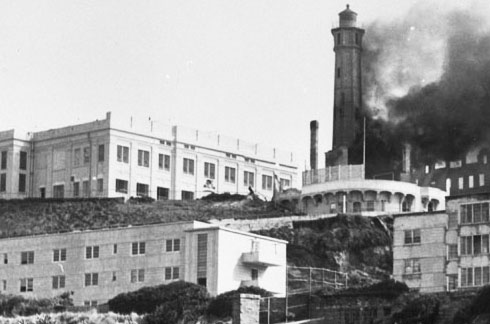
A building burns during the Native American occupation
On March 21, 1963, USP Alcatraz closed after 29 years of operation. It did not close because of the disappearance of Morris and the Anglins (the decision to close the prison was made long before the three disappeared), but because the institution was too expensive to continue operating. An estimated 3−5millionwasneededjustforrestorationandmaintenanceworktokeeptheprisonopen.Thatfiguredidnotincludedailyoperatingcosts−AlcatrazwasnearlythreetimesmoreexpensivetooperatethananyotherFederalprison(in1959thedailypercapitacostatAlcatrazwas3-5 million was needed just for restoration and maintenance work to keep the prison open. That figure did not include daily operating costs - Alcatraz was nearly three times more expensive to operate than any other Federal prison (in 1959 the daily per capita cost at Alcatraz was 3−5millionwasneededjustforrestorationandmaintenanceworktokeeptheprisonopen.Thatfiguredidnotincludedailyoperatingcosts−AlcatrazwasnearlythreetimesmoreexpensivetooperatethananyotherFederalprison(in1959thedailypercapitacostatAlcatrazwas10.10 compared with $3.00 at USP Atlanta). The major expense was caused by the physical isolation of the island - the exact reason islands have been used as prisons throughout history. This isolation meant that everything (food, supplies, water, fuel...) had to be brought to Alcatraz by boat. For example, the island had no source of fresh water, so nearly one million gallons of water had to be barged to the island each week. The Federal Government found that it was more cost-effective to build a new institution than to keep Alcatraz open.
After the prison closed, Alcatraz was basically abandoned. Many ideas were proposed for the island, including a monument to the United Nations, a West Coast version of the Statue of Liberty, and a shopping center/hotel complex. In 1969, the island again made news when a group of Native American Indians claimed Alcatraz as Indian land with the hope of creating a Native American cultural center and education complex on the island. The "Indians of All Tribes" used their act of civil disobedience to illustrate the troubles faced by Native Americans. Initially, public support for the Native Americans' cause was strong, and thousands of people (general public, schoolchildren, celebrities, hippies, Vietnam war protesters, Hells Angels...) came to the island over the next 18 months. Unfortunately, the small Native American leadership group could not control the situation and much damage occurred (graffiti, vandalism, and a fire that destroyed the lighthouse keeper's home, the Warden's home, and the Officers' Club). In June 1971, Federal Marshals removed the remaining Native Americans from the island.
Alcatraz Today
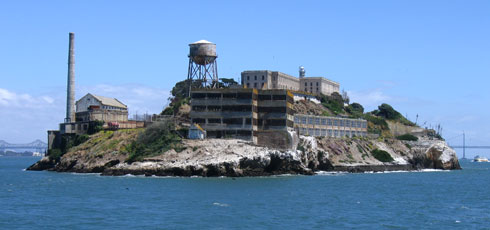
A view of Alcatraz Island today
In 1972, Congress created the Golden Gate National Recreation Area, and Alcatraz Island was included as part of the new National Park Service unit. The island opened to the public in the fall of 1973 and has become one of the most popular Park Service sites - more than one million visitors from around the world visit the island each year.
If you would like more information about Alcatraz, visit the National Park Service Web site.